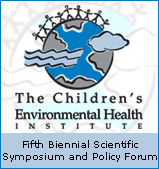| Effect of Prenatal Exposure to Airborne Polycyclic Aromatic Hydrocarbons on Neurodevelopment in the First 3 Years of Life among Inner-City Children Frederica P. Perera,1 Virginia Rauh,1 Robin M. Whyatt,1 Wei-Yann Tsai,1,2 Deliang Tang,1 Diurka Diaz,1 Lori Hoepner,1 Dana Barr,3 Yi-Hsuan Tu,1 David Camann,4 and Patrick Kinney1 1Columbia Center for Children's Environmental Health, Mailman School of Public Health, Columbia University, New York, New York, USA; 2Department of Statistics, National Cheng Kung University, Taiwan, Republic of China; 3Centers for Disease Control and Prevention, National Center for Environmental Health, Division of Laboratory Sciences, Atlanta, Georgia, USA; 4Department of Analytical and Environmental Chemistry, Southwest Research Institute, San Antonio, Texas, USA Abstract
Our prospective cohort study of nonsmoking African-American and Dominican mothers and children in New York City is evaluating the role of prenatal exposure to urban pollutants, including polycyclic aromatic hydrocarbons (PAHs) , environmental tobacco smoke (ETS) , and pesticides, in the pathogenesis of neurobehavioral disorders. We used the Bayley Scales of Infant Development to evaluate the effects on child mental and psychomotor development of prenatal exposure to airborne PAHs monitored during pregnancy by personal air sampling. Behavioral development was assessed by the Child Behavior Checklist. We adjusted for potential confounders including sociodemographic factors and prenatal exposure to ETS and chlorpyrifos. Prenatal exposure to PAHs was not associated with psychomotor development index or behavioral problems. However, high prenatal exposure to PAHs (upper quartile) was associated with lower mental development index at age 3 [β = –5.69 ; 95% confidence interval (CI) , –9.05 to –2.33 ; p < 0.01]. The odds of cognitive developmental delay were also significantly greater for children with high prenatal exposure (odds ratio = 2.89 ; 95% CI, 1.33 to 6.25 ; p = 0.01) . General estimated equation analysis showed a significant age  PAH effect on mental development (p = 0.01) , confirming the age-specific regression findings. Further adjustment for lead did not alter the relationships. There were no differences in effect sizes by ethnicity. The results require confirmation but suggest that environmental PAHs at levels recently encountered in New York City air may adversely affect children's cognitive development at 3 years of age, with implications for school performance. Key words: air pollution, neurodevelopment, polycyclic aromatic hydrocarbons, prenatal. Environ Health Perspect 114:1287–1292 (2006) . doi:10.1289/ehp.9084 available via http://dx.doi.org/ [Online 24 April 2006] PAH effect on mental development (p = 0.01) , confirming the age-specific regression findings. Further adjustment for lead did not alter the relationships. There were no differences in effect sizes by ethnicity. The results require confirmation but suggest that environmental PAHs at levels recently encountered in New York City air may adversely affect children's cognitive development at 3 years of age, with implications for school performance. Key words: air pollution, neurodevelopment, polycyclic aromatic hydrocarbons, prenatal. Environ Health Perspect 114:1287–1292 (2006) . doi:10.1289/ehp.9084 available via http://dx.doi.org/ [Online 24 April 2006]
Address correspondence to F.P. Perera, Columbia Center for Children's Environmental Health, Mailman School of Public Health, Columbia University, 60 Haven Ave., B-109, New York, NY 10032 USA. Telephone: (212) 304-7280. Fax: (212) 544-1943. E-mail: fpp1@columbia.edu We acknowledge H. Andrews, R. Garfinkel, Y.H. Jin, L. Qu, J. Zhou, A. Reyes, and M. Borjas at the Columbia Center for Children's Environmental Health, and L. Needham, T. Bernert, R. Jones, and K. Caldwell at the Centers for Disease Control and Prevention. This study was supported by the National Institute of Enviromental Health Sciences (5P01ES09600, 5RO1ES08977, RO1ES111158, RO1ES012468, ES09089) , the U.S. Environmental Protection Agency (R827027, 8260901, RR00645) , Educational Foundation of America, Horace W. Goldsmith Foundation, the Irving A. Hansen Memorial Foundation, Gladys & Roland Harriman Foundation, the New York Community Trust, the Bauman Family Foundation, the Beldon Fund, and the John Merck Fund. The authors declare they have no competing financial interests. Received 10 February 2006 ; accepted 27 April 2006.
The full version of this article is available for free in HTML or PDF formats. |

